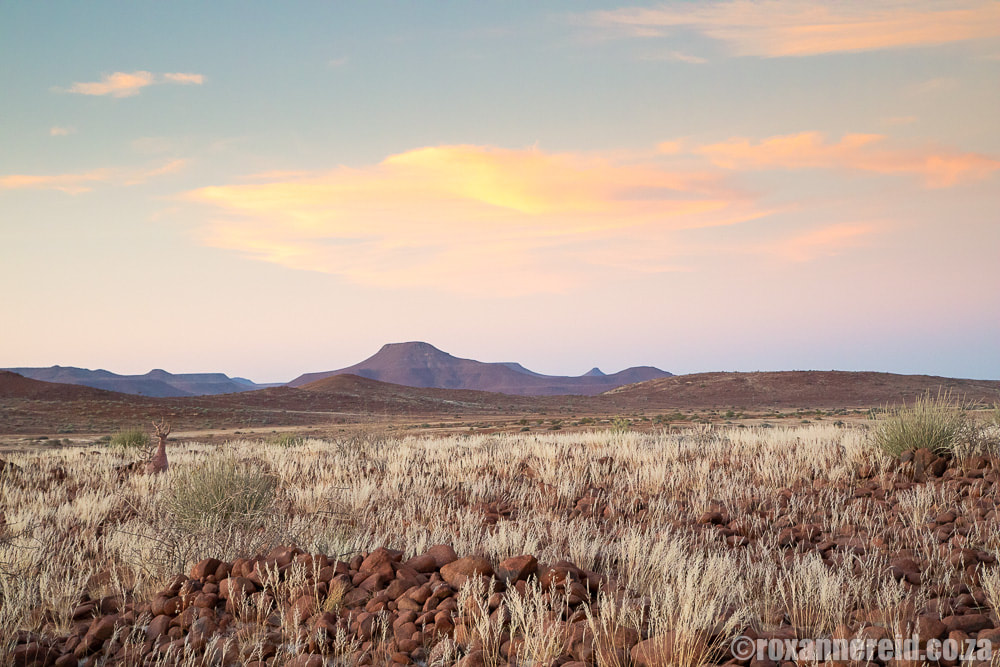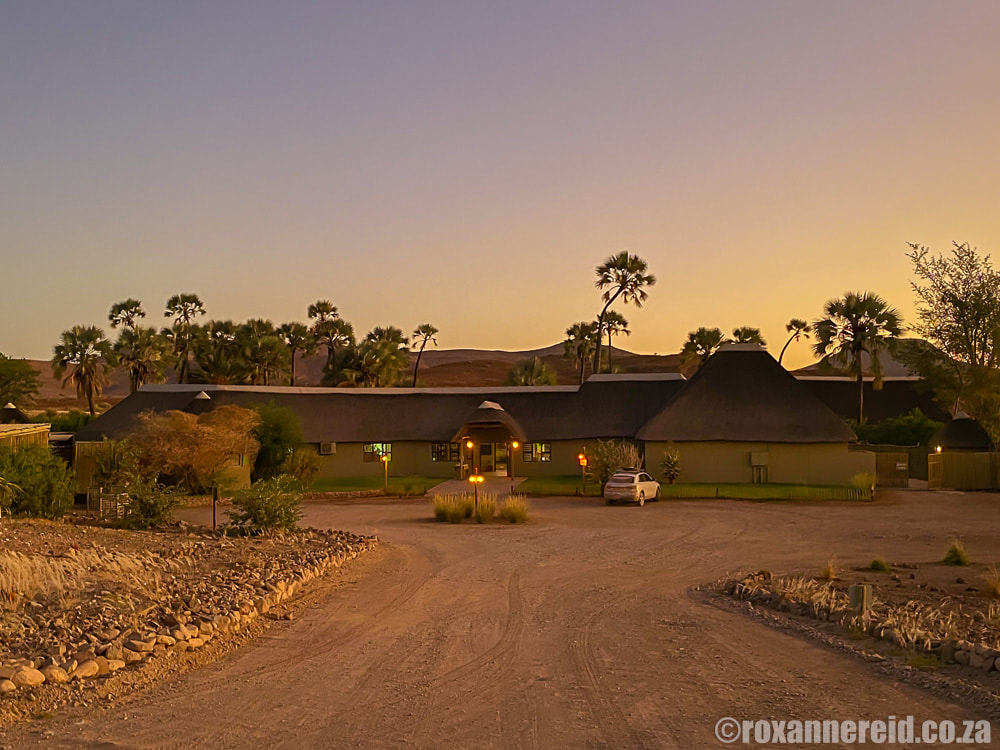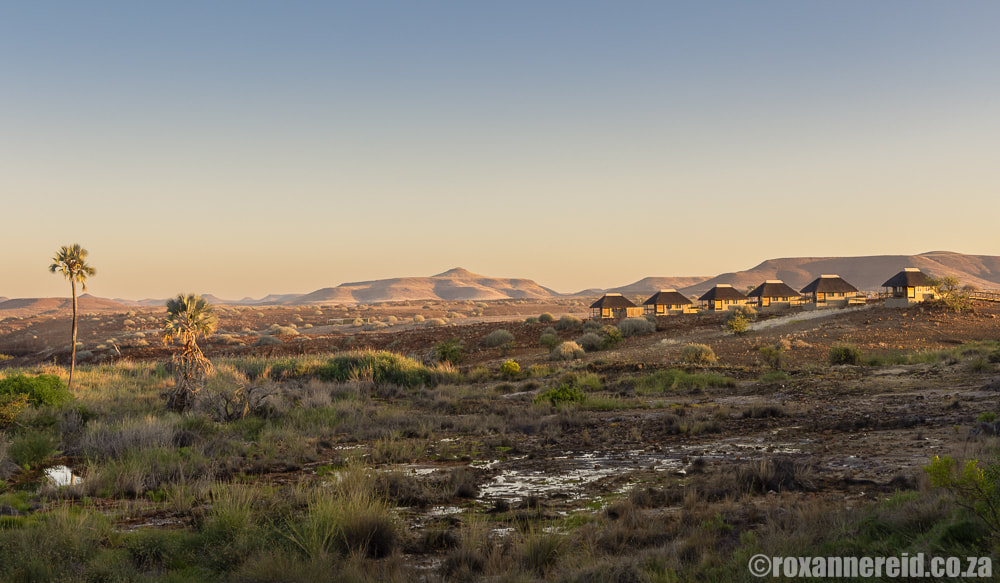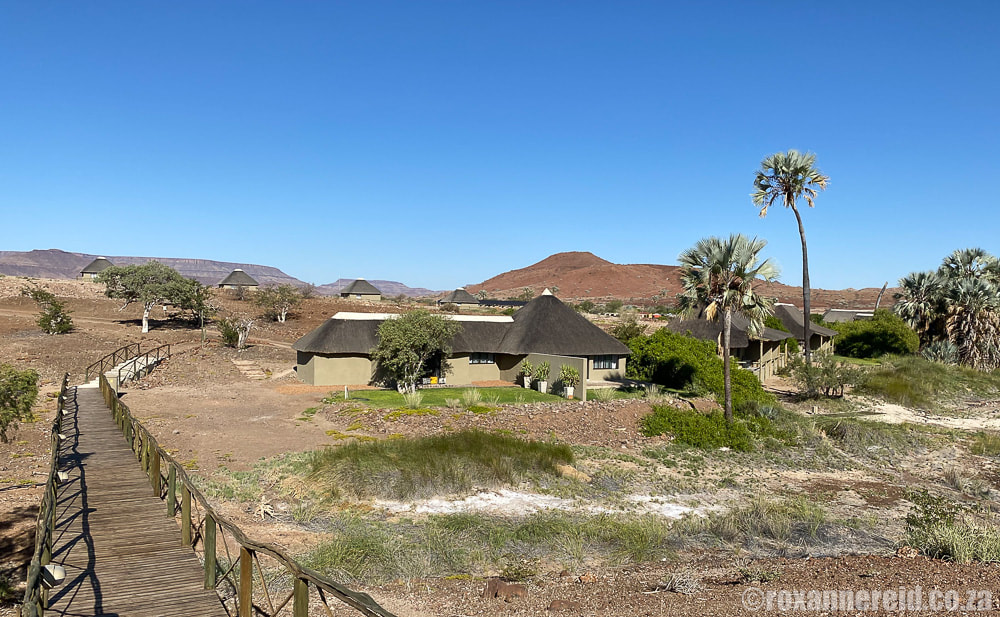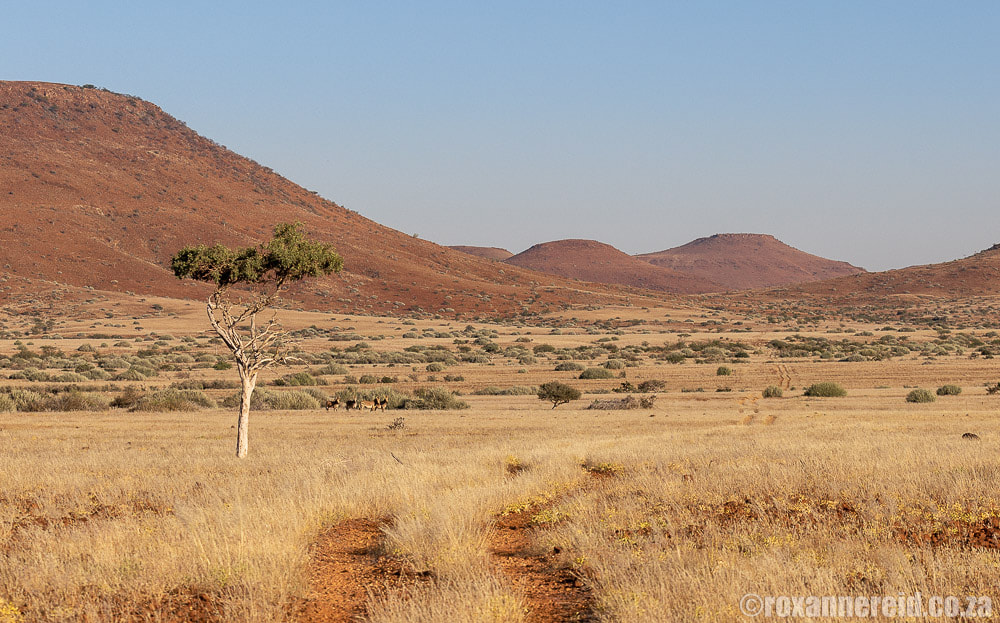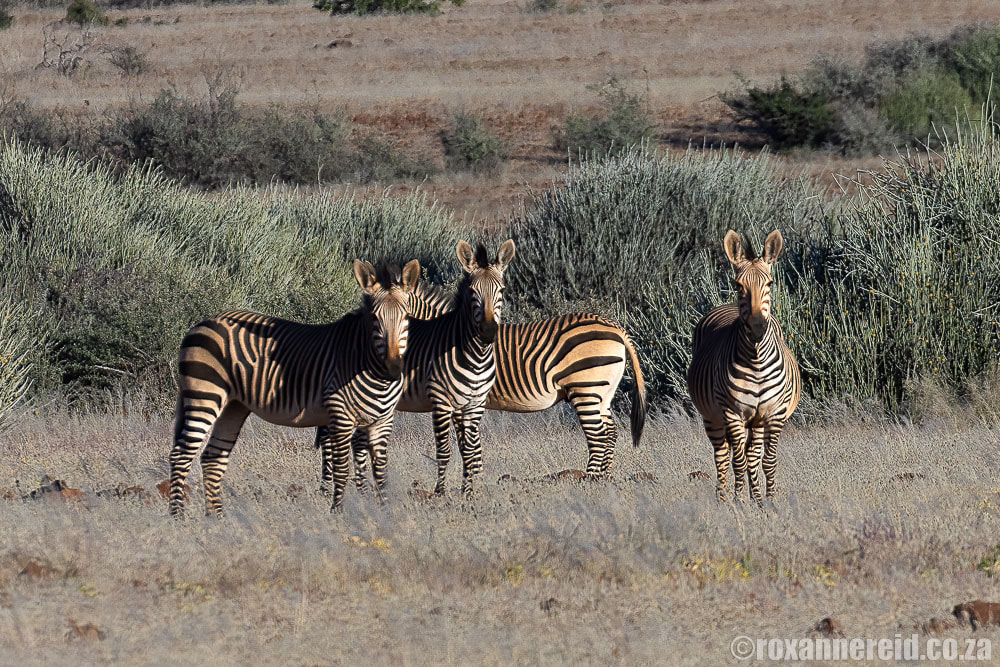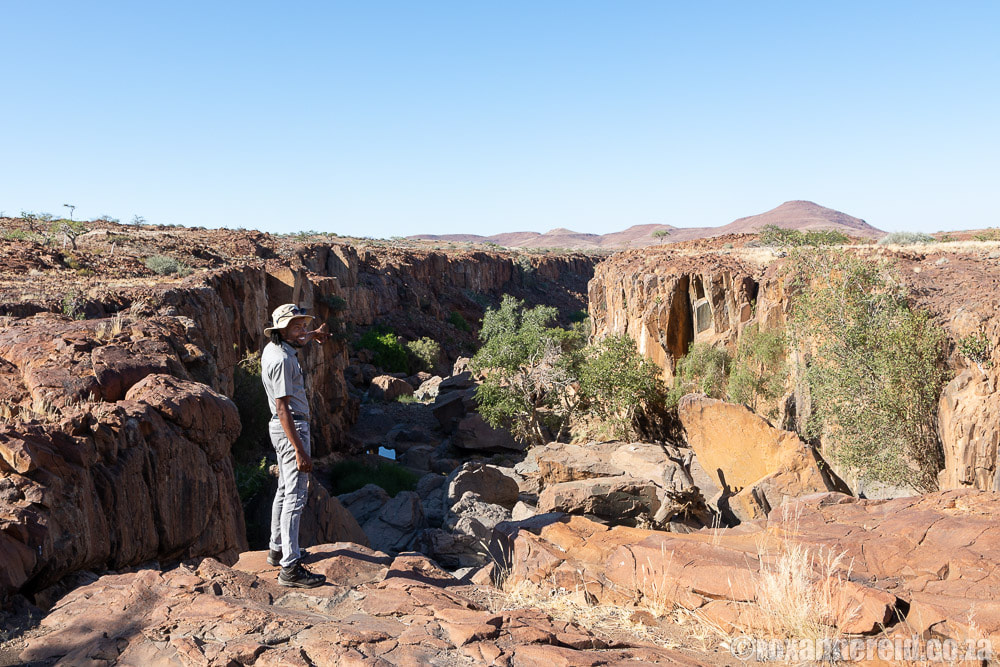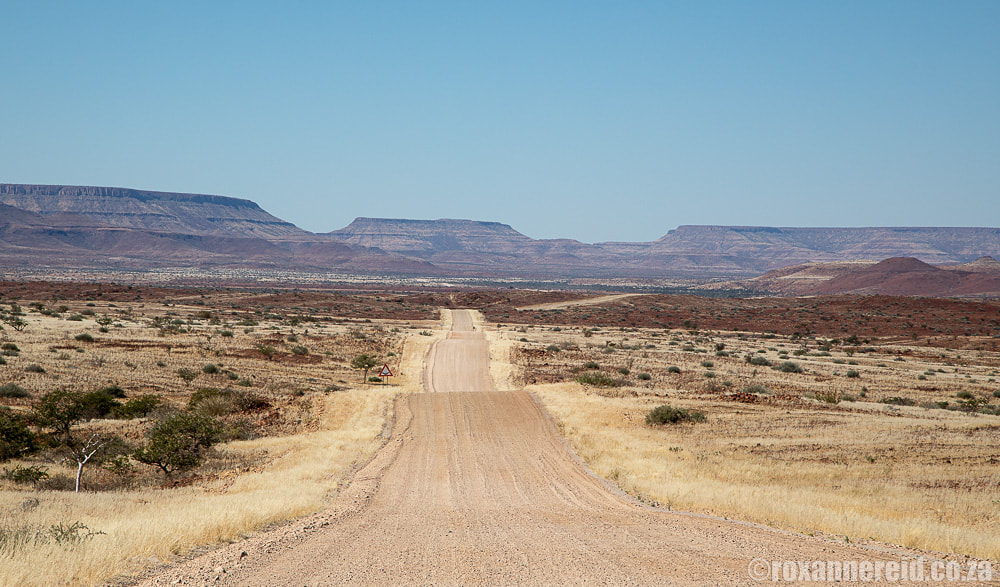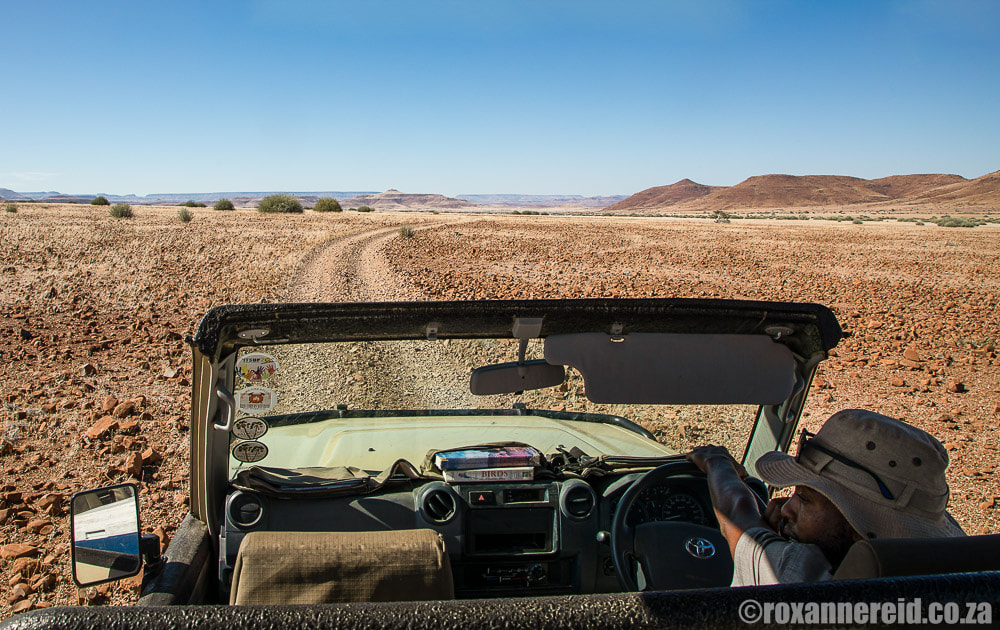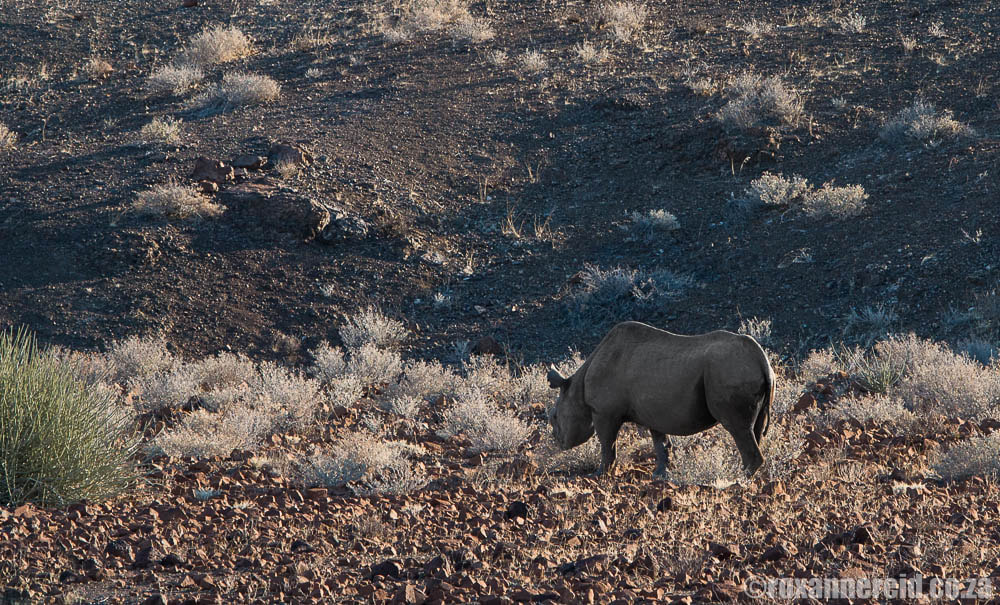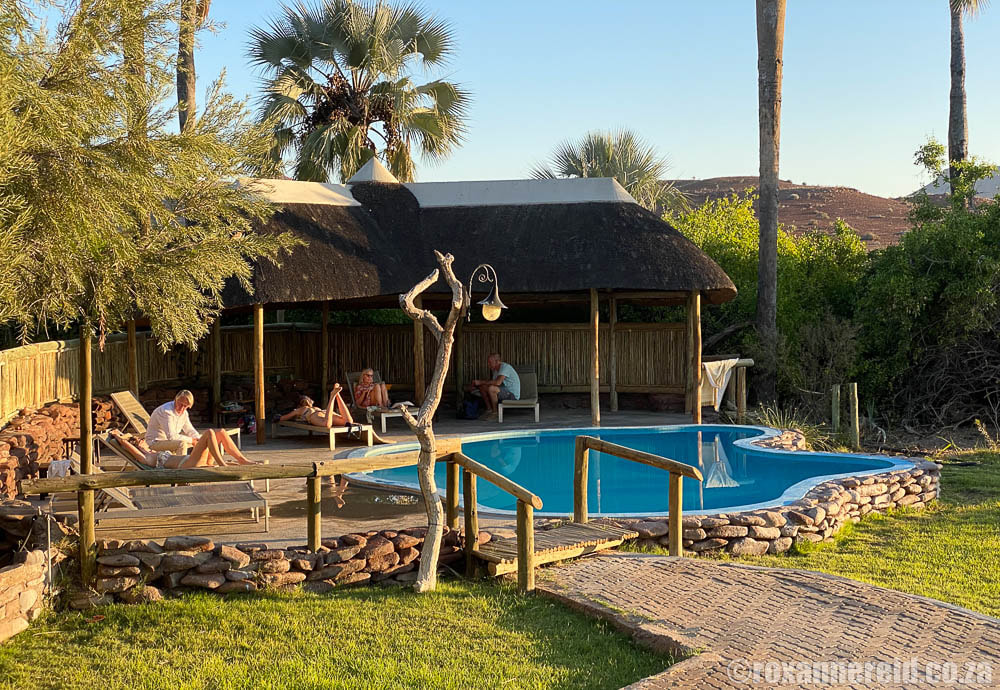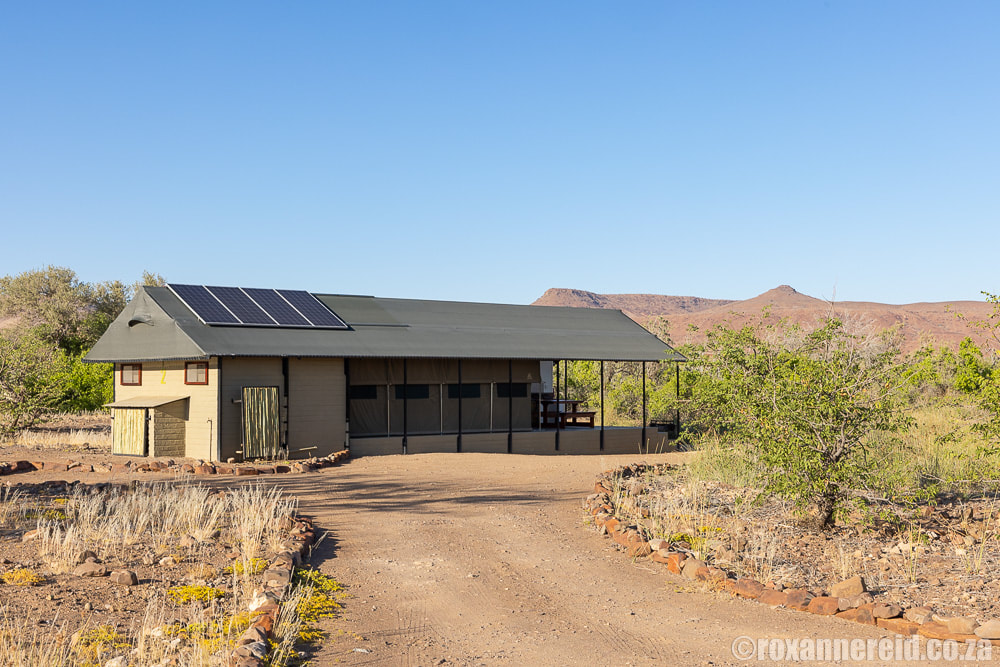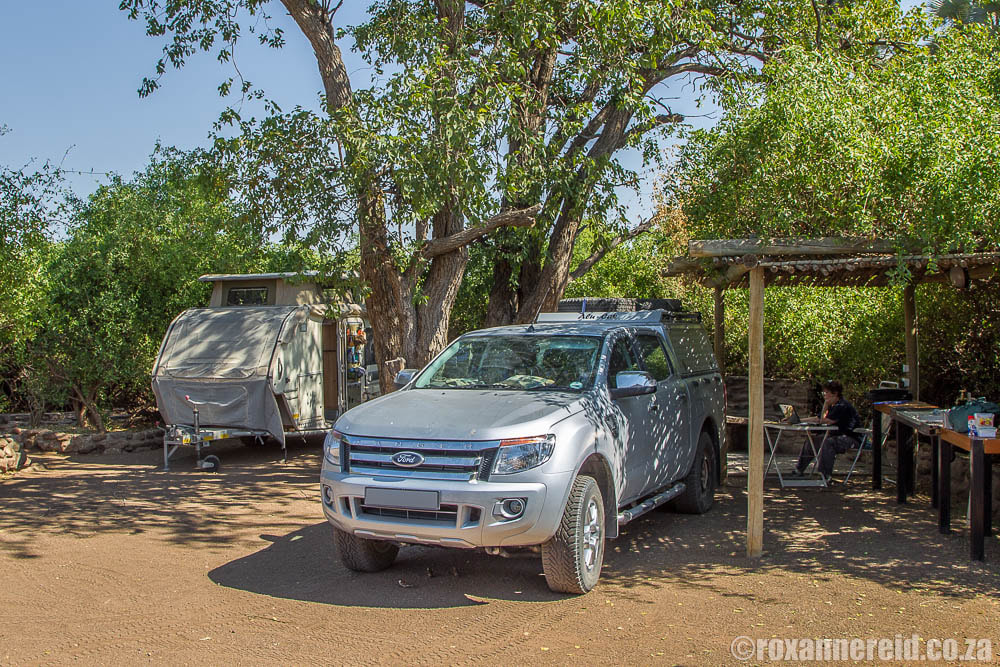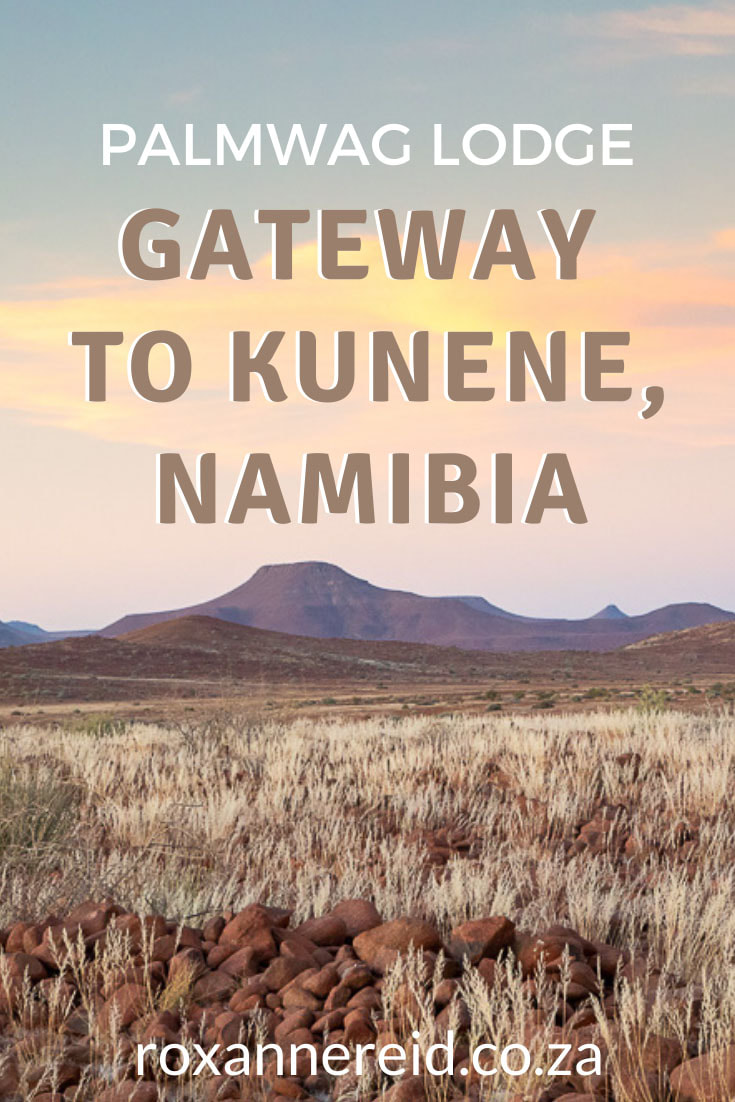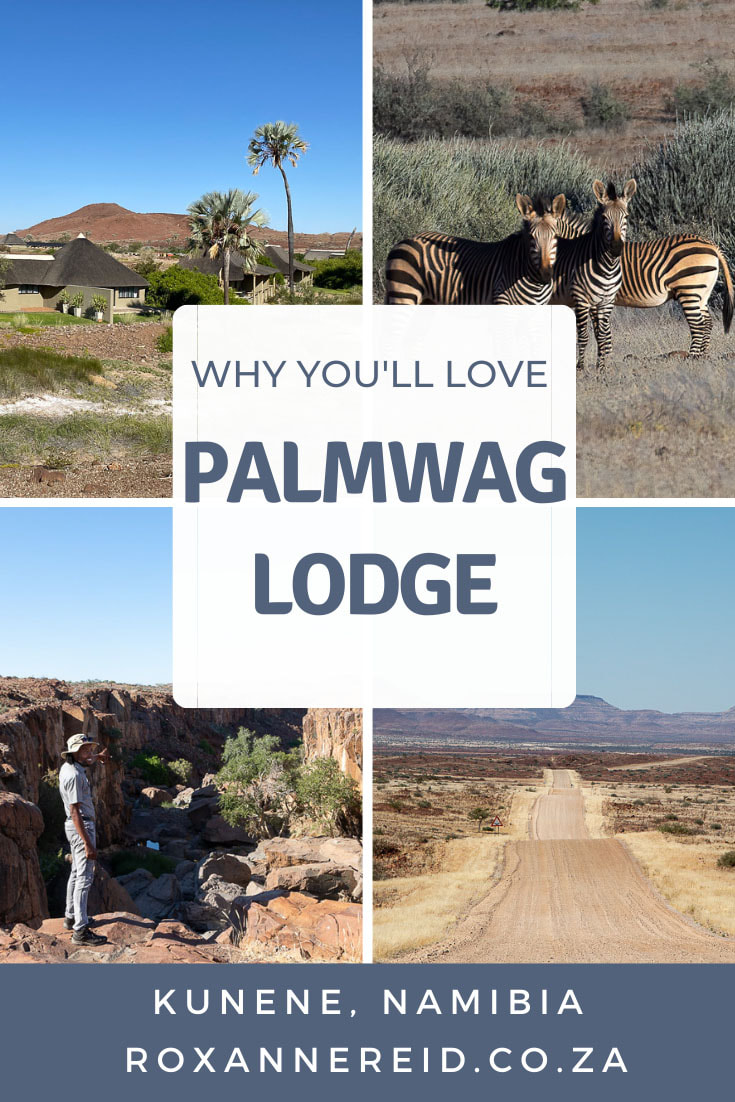By Roxanne Reid
Palmwag Lodge & Camp in Damaraland, part of Namibia’s rough-and-tumble Kunene region, is a peaceful green oasis in a landscape of basalt rocks. If you love intense 4x4 routes, Himba settlements and stark desert landscapes, this is your gateway to remote places like Sesfontein, Opuwo, the Marienfluss, Van Zyl’s Pass and Epupa Falls.
Palmwag Lodge & Camp in Damaraland, part of Namibia’s rough-and-tumble Kunene region, is a peaceful green oasis in a landscape of basalt rocks. If you love intense 4x4 routes, Himba settlements and stark desert landscapes, this is your gateway to remote places like Sesfontein, Opuwo, the Marienfluss, Van Zyl’s Pass and Epupa Falls.
You’ll find Palmwag Lodge & Camp about 80km west of Kamanjab, a beautiful drive through the flat-topped Etendeka mountains and over the 1600m Grootberg Pass along the C40. It’s about 160km north-west of Khorixas along the C39 and C43, and 200km east of Terrace Bay in the Skeleton Coast National Park, a take-no-prisoners wilderness where beaches are veiled in fog and the sea is pocked with shipwrecks.
The lodge lies next to an underground spring in the Uniab River where makalani palm trees sway in the breeze. During dry times, the water may entice an elephant to the lodge or camp, providing much excitement for visitors. We’ve seen one of these grey giants here in the past, but not on our most recent visit; there’d been good rains earlier in the year and there was plenty water for them in the veld far away from the lodge.
The almost unearthly landscape of dark red basalt rocks around here was created by volcanic activity some 130 million years ago, before the landmass of Gondwana broke apart. The rocks also contain quartz and iron, which has oxidised over aeons to give them a rusty colour. A scattering of yellow grass forms a counterpoint, grey-green euphorbias dot the landscape, and burnished or blue-grey mountains lie all around, especially striking at dawn and dusk when they’re drenched in painted shadows.
For me, the magic of this wide-open wilderness is the overwhelming sense of freedom. For a few days, you can put the brakes on the noise in your head, breathe deeply and let your heart dance to a slower rhythm.
For me, the magic of this wide-open wilderness is the overwhelming sense of freedom. For a few days, you can put the brakes on the noise in your head, breathe deeply and let your heart dance to a slower rhythm.
There are two main areas at Palmwag Lodge & Camp. The lodge’s main area includes a pool and large thatched restaurant and bar, where wide verandahs look out over the reeds and palm trees along the river. The second hub is at the Palmwag Campsite next door, where there’s another pool and a thatched bar and coffeeshop.
Our free-standing thatched chalet had a restful colour palette, with grey curtains and olive-green and yellow accents on throws and cushions. It had everything we needed, including a large shower, cupboard, tea station and air conditioner. My favourite spot was the small stoep, where we could plunk down into directors’ chairs to enjoy our surroundings once the bite went out of the midday heat.
Things to do at Palmwag Lodge & Camp
1. Spend half a day in the Palmwag Concession
There’s nothing I love more than spending time in nature, the wilder the better. That’s why we set off early one morning from Palmwag Lodge with guide Sebethelis Gaobaëb (nicknamed Zepe) for the entrance to the Palmwag Concession 17km away. This is a 5500 square-kilometre protected area and adjoins the even more untamed Skeleton Coast National Park to the west.
It was winter and the air was slapped with cold when we left in the open safari vehicle at 7:00. By 7:30 the sun had just come up and was skimming the tops of the ruddy mountains around us while the grasslands were still in shadow. The landscapes here are beautiful in their stark way, with red volcanic basalt rock, shepherd trees, mopane, purple-pod cluster-leaf and bottle trees, as well as ringwood trees that browsing giraffes trim into a flat umbrella shape.
It was winter and the air was slapped with cold when we left in the open safari vehicle at 7:00. By 7:30 the sun had just come up and was skimming the tops of the ruddy mountains around us while the grasslands were still in shadow. The landscapes here are beautiful in their stark way, with red volcanic basalt rock, shepherd trees, mopane, purple-pod cluster-leaf and bottle trees, as well as ringwood trees that browsing giraffes trim into a flat umbrella shape.
We’ve been to the Palmwag area many times but never before have we seen so much long yellow grass – the result, Zepe said, of 50mm of rain from December to March. It may not seem like much, but it’s substantial for an area often brittled by drought.
From the gate, we headed slowly towards the Aub Canyon. We saw oryx (gemsbok), a big herd of some 150 springbok, Hartmann’s mountain zebras with foals, and Ruppell’s korhaan parents with a half-grown chick. We listened to the liquid call of the Namaqua sandgrouse, saw Namaqua doves at a permanent underground spring, watched a troop of baboons with cheeky babies riding like jockeys, some rowdy bare-cheeked babblers, and an ostrich family of mom, pop and seven half-grown chicks strutting across the veld.
Proof of the good rains earlier this year was that the Aub Canyon still had water in it in mid-May. We explored the basalt cliffs on foot, reveling in the sight and sound of water purling over rocks below. After coffee and snacks at a table set out under a mopane tree, we began the return drive, eager to see what else we might find.
From the gate, we headed slowly towards the Aub Canyon. We saw oryx (gemsbok), a big herd of some 150 springbok, Hartmann’s mountain zebras with foals, and Ruppell’s korhaan parents with a half-grown chick. We listened to the liquid call of the Namaqua sandgrouse, saw Namaqua doves at a permanent underground spring, watched a troop of baboons with cheeky babies riding like jockeys, some rowdy bare-cheeked babblers, and an ostrich family of mom, pop and seven half-grown chicks strutting across the veld.
Proof of the good rains earlier this year was that the Aub Canyon still had water in it in mid-May. We explored the basalt cliffs on foot, reveling in the sight and sound of water purling over rocks below. After coffee and snacks at a table set out under a mopane tree, we began the return drive, eager to see what else we might find.
Other mammals in the concession include kudu, klipspringer, leopard, spotted hyena, giraffe, elephant, lion and rhino. Unfortunately, although the guard at the gate had told us where the lions were, Zepe said it was too far to drive in half a day. Also, the elephants had moved away from the permanent water at the camp because there are water sources in the veld after the rains.
Apart from the animals, the best things on the way back were the changing views of the Etendeka plateau, a blue-grey frieze on the horizon ahead of us. The word Etendeka means ‘mountain with flat top’, and they have a fascinating backstory. They’re the result of a basalt flow 132 million years ago after a colossal volcanic eruption – way back before southern Africa and South America split apart.
2. Splash out on a full-day nature drive
2. Splash out on a full-day nature drive
The rangers at the Palmwag Concession keep tabs on the whereabouts of animals like lions and elephants but they were too far away for us to see them on our half-day nature drive (see point 1). If you sign up for a full-day Damaraland experience, though, you have a better chance of having time to travel to where they’ve most recently been seen.
Along the way you’ll be able to marvel at the landscapes and red rocks, and learn from your guide about the geology of the area. You may also see animals like Hartmann’s zebra, oryx (gemsbok), giraffe and antelope, and birds like Herero chat, Rüppell’s parrot, longbilled lark, rockrunner, bare-cheeked babbler and violet woodhoopoe.
3. Track a desert rhino
Along the way you’ll be able to marvel at the landscapes and red rocks, and learn from your guide about the geology of the area. You may also see animals like Hartmann’s zebra, oryx (gemsbok), giraffe and antelope, and birds like Herero chat, Rüppell’s parrot, longbilled lark, rockrunner, bare-cheeked babbler and violet woodhoopoe.
3. Track a desert rhino
To enjoy a once-in-a-lifetime experience, go on a half-day rhino tracking drive into the Palmwag Concession. This operates in collaboration with trackers from the Save the Rhino Trust, Namibia.
In the 1960s, there were an estimated 100 000 black rhino in Africa, but poaching has cut a swathe through these populations until only some 5000 individuals remain in the wild. Here in north-western Namibia, the Save the Rhino Trust is putting in long hours and thousands of kilometres by vehicle and on foot through rough terrain to protect these prehistoric animals for future generations. Every time they spot a rhino they note in an ID book where it’s found, what it’s doing, which specific animal it is. They identify individuals by horn shape and ear notches, which happen from fighting or when rhinos barge through bushes. The trackers also note its condition on a scale of 1-5.
In an open safari vehicle you’ll get to an area where a rhino has been located and then approach closer on foot. What a thrill when, about 150m away and surrounded by red rocks and a scattering of welwitschia plants, you see a desert-adapted black rhino browsing on a euphorbia. It’s overwhelming and humbling to watch this magnificent free-roaming creature in its own environment, to know how ancient the species is and yet how threatened with possible extinction by poaching.
4. Go on a guided walk
In the 1960s, there were an estimated 100 000 black rhino in Africa, but poaching has cut a swathe through these populations until only some 5000 individuals remain in the wild. Here in north-western Namibia, the Save the Rhino Trust is putting in long hours and thousands of kilometres by vehicle and on foot through rough terrain to protect these prehistoric animals for future generations. Every time they spot a rhino they note in an ID book where it’s found, what it’s doing, which specific animal it is. They identify individuals by horn shape and ear notches, which happen from fighting or when rhinos barge through bushes. The trackers also note its condition on a scale of 1-5.
In an open safari vehicle you’ll get to an area where a rhino has been located and then approach closer on foot. What a thrill when, about 150m away and surrounded by red rocks and a scattering of welwitschia plants, you see a desert-adapted black rhino browsing on a euphorbia. It’s overwhelming and humbling to watch this magnificent free-roaming creature in its own environment, to know how ancient the species is and yet how threatened with possible extinction by poaching.
4. Go on a guided walk
Go on an early morning walk with a guide, who will share his knowledge of the smaller wildlife, their tracks and signs, as well as the plants and geology of Damaraland. You can choose a 2km walk (about 1.5 hours) or a 5km walk (about 3 hours). The walks explore a koppie near the lodge and then loop back. Use it as a chance to spot some of the birds that occur in this dry land, and to appreciate the minimalist allure of the surrounding landscape.
5. Sleep out in the Palmwag Concession
Do you think of yourself as adventurous? Does the idea of seeing millions of stars as you eat your dinner around a campfire in the Palmwag Concession appeal to you? Then this sleep-out will make your heart sing.
A guided afternoon drive will take you to the Palmwag Concession, where you’ll find your tents set up and staff ready to welcome you for a night of camp fire, stars and good food in natural surroundings. After dinner and stories around the fire, duck into your tent to fall asleep to the sounds of the night. Wake in the morning to a slap-up breakfast around the fire before heading back to the lodge.
Note that this is rustic camping for a minimum of two people and a maximum of eight. If you prefer more luxury, rather stay at the lodge or in the glamping tents (see point 9).
6. Cool off in one of the swimming pools
5. Sleep out in the Palmwag Concession
Do you think of yourself as adventurous? Does the idea of seeing millions of stars as you eat your dinner around a campfire in the Palmwag Concession appeal to you? Then this sleep-out will make your heart sing.
A guided afternoon drive will take you to the Palmwag Concession, where you’ll find your tents set up and staff ready to welcome you for a night of camp fire, stars and good food in natural surroundings. After dinner and stories around the fire, duck into your tent to fall asleep to the sounds of the night. Wake in the morning to a slap-up breakfast around the fire before heading back to the lodge.
Note that this is rustic camping for a minimum of two people and a maximum of eight. If you prefer more luxury, rather stay at the lodge or in the glamping tents (see point 9).
6. Cool off in one of the swimming pools
There are two swimming pools at Palmwag, one near the lodge’s dining room and the other next to the campsite. Go for a dip on a hot day, or sit on a pool-side lounger to relax and unwind before your next adventure. There’s a coffeeshop and bar next to the campsite pool which is a super place to have lunch – if, that is, you’re hungry after your whopping breakfast at the lodge.
7. Have sundowners around the fire
Between the pool and dining room at the lodge is an open courtyard area where on chilly nights staff light a fire. Pull up a camp chair, order a drink from the bar, and settle in for a wide-screen view of a dramatic Damaraland sunset. The makalani palms along the Uniab River become silhouetted against the ever-changing hues. See the burnt orange glow along the horizon, softening to pink and mauve, listen to the palm leaves rustle in the breeze.
8. Enjoy dinner at sunset
7. Have sundowners around the fire
Between the pool and dining room at the lodge is an open courtyard area where on chilly nights staff light a fire. Pull up a camp chair, order a drink from the bar, and settle in for a wide-screen view of a dramatic Damaraland sunset. The makalani palms along the Uniab River become silhouetted against the ever-changing hues. See the burnt orange glow along the horizon, softening to pink and mauve, listen to the palm leaves rustle in the breeze.
8. Enjoy dinner at sunset
To extend your sunset joy – because the colours continue to intensify once the sun has slipped below the horizon – enjoy dinner in the thatched, open dining room with the same Imax view of the palms and shifting colours. The best spots for the view are the tables along the front edge, though it can get nippy there if a cold wind is blowing.
There’s a great spread every night, with chicken, beef, lamb, venison and roast potatoes making regular appearances. There are lots of salads and fresh vegetables for non-carnivores. Veg like carrots and beetroot come from the gardens at sister property, Damara Mopane Lodge, about 180km away. I try not to eat dessert often, but I had to give in to the lemon and berry pud.
9. Go glamping
There’s a great spread every night, with chicken, beef, lamb, venison and roast potatoes making regular appearances. There are lots of salads and fresh vegetables for non-carnivores. Veg like carrots and beetroot come from the gardens at sister property, Damara Mopane Lodge, about 180km away. I try not to eat dessert often, but I had to give in to the lemon and berry pud.
9. Go glamping
The great thing about glamping at Palmwag Camping2Go is that you can choose one of three ways to go about it. One, you can self-cater (all the braai and kitchen equipment you need is provided; just bring your own food and drinks). Two, you can choose merely to relax and sleep there but book dinner at the lodge. Or three, you can get the best of both worlds by making use of prepared items off the Camping2Go menu. These include bread, garlic bread, braaibroodjies (sandwiches to be cooked over the fire), mixed salad, potato salad, and a meat pack for you to braai yourself. You can buy firewood here too.
Each glamping tent has four beds, so is ideal either for couples or families. There’s an en suite bathroom with large shower and flush loo. The outdoor kitchen under a shade awning at the front has a fridge/freezer, double gas cooker and sink. All the pots, pans, crockery and cutlery you need are also supplied. There’s a moveable braai as well as a firepit so you can gather round to listen to the crackle of the flames and admire the stars in their millions here far away from Big City lights.
Facilities at the nearby campsite are open to glampers too. Take a swim in the campsite’s pool or treat yourself to lunch at the coffeeshop. You can also book ahead for activities like walks or drives (see numbers 1-4 above).
10. Pitch your own tent
Each glamping tent has four beds, so is ideal either for couples or families. There’s an en suite bathroom with large shower and flush loo. The outdoor kitchen under a shade awning at the front has a fridge/freezer, double gas cooker and sink. All the pots, pans, crockery and cutlery you need are also supplied. There’s a moveable braai as well as a firepit so you can gather round to listen to the crackle of the flames and admire the stars in their millions here far away from Big City lights.
Facilities at the nearby campsite are open to glampers too. Take a swim in the campsite’s pool or treat yourself to lunch at the coffeeshop. You can also book ahead for activities like walks or drives (see numbers 1-4 above).
10. Pitch your own tent
Prefer to do your own thing with your ground or roof tent or trailer? You’ll love Palmwag Campsite right next door to the lodge. We’ve camped there often and enjoyed it each time. Ablutions are rustic – the walls made from reeds – but always clean and well cared for. Since the Gondwana Collection took over ownership of the lodge and camp in 2019, they have created two new campsites, numbers 14 and 15, placed on the route to the Camping2Go glamping tents. These are more spacious than the other sites and suitable for bigger groups.
Read more about our experiences at Palmwag Campsite.
Need to know
You may also enjoy
Places to visit and things to do in Namibia: the north
Palmwag campsite: an oasis in Kunene, Namibia
Damara Mopane Lodge near Khorixas, Namibia
Like it? Pin this image!
Read more about our experiences at Palmwag Campsite.
Need to know
- In this vast open area where towns are few and far between, it’s good to know that you can buy fuel at Palmwag – both diesel and 95 unleaded. Pay with your Master or Visa credit card or with cash (either Namibian dollars or South African rands).
- There is wifi at the lodge, though signal is best in the main areas.
- There’s a small shop next to reception that sells locally made curios and mementos of your Namibian holiday.
- If you plan to visit more than one or two of the Gondwana Collection’s lodges or camps, consider buying a Gondwana Card. It gives 50% discount on accommodation to Namibians and 40% discount to visitors from SADC countries. There are also discounts on meals, activities, Camping2Go and campsites. Check here for all the details.
- Looking to hire a vehicle? For anything from a Toyota Fortuner or Suzuki Jimny to a people carrier, 4x4 Hilux or Landcruiser fully equipped for camping, contact Gondwana’s Namibia2Go car rental division.
- See all the Gondwana Collection lodges and campsites around Namibia here. To book for a Gondwana Collection lodge, Camping2Go or campsite: email bookings@gondwana-collection.com, tel +264 61 427 200 or +264 81 129 2424 (after hours).
You may also enjoy
Places to visit and things to do in Namibia: the north
Palmwag campsite: an oasis in Kunene, Namibia
Damara Mopane Lodge near Khorixas, Namibia
Like it? Pin this image!
Copyright © Roxanne Reid - No words or photographs on this site may be used without permission from roxannereid.co.za
